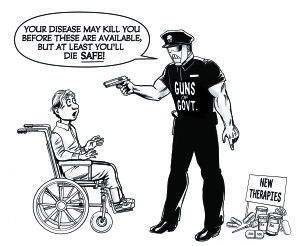If you were terminally ill, you might wish to try a drug that hadn’t yet been fully tested, but might save your life. In the United States, however, that would make you a criminal.
In 1962, Amendments to the Food and Drug Act gave the US Food and Drug Administration (FDA) unprecedented power to regulate the pharmaceutical industry. As a result, an additional 8-10 years was added to the time it takes to get a drug from the lab bench to the marketplace.
AIDS patients couldn’t wait that long. They hired black market chemists to make the drugs that industry scientists were working on and distributed them throughout the AIDS community. Although this action was illegal, the FDA left some of the Buyers Clubs alone, while prosecuting others (e.g., Ron Woodroof, who has been immortalized in the award-winning 2013 movie, Dallas Buyers Club).
Cancer patients took the FDA to court to legalize their ability to use drugs that had undergone human safety testing but had not yet been shown to be effective. The courts ruled that US citizens did not have the right to try to save their lives with drugs not yet approved by the FDA. Consequently, some patients are now going to the black market or overseas to get drugs that might help them survive.
The extra testing that the FDA now requires means that pharmaceutical firms must spend time and money pleasing the FDA instead of inventing new cures for diseases. Consequently, innovation has dropped at least 50% from 1962 levels.
When I was working at the Upjohn Company in the 1980s, the FDA called to congratulate me on a patent that I had filed for prostaglandin treatment of liver disease. They wanted to help Upjohn bring a prostaglandin drug to market because there was no treatment for this deadly problem. However, as with all new drugs, we didn’t know what dose would be best, how often the drug needed to be given, how many patients we would need to treat, how long we needed to treat, etc., in order to get the “statistical significance” that the FDA required. Since these studies would take years, if we didn’t guess right the first time, we would have to start over. By the time our drug got to market it would no longer be covered by a patent. Consequently, we could never recover our costs. The Upjohn Company decided not to develop this drug, and patients today are still dying of a disease for which there might have been hope.
The studies demanded by the FDA are responsible for about 80% of the cost of new drugs today. If these studies actually made drugs safer, they might be worth the extra time and money. However, all the evidence points in the other direction. The biggest drug disaster of all time, Vioxx, was an FDA approved drug.
No drug is perfectly safe, nor can animal studies or the limited clinical trials that are performed for marketing, predict every side effect. People differ in their genetics, environment, diet and other factors, so drug toxicity cannot always be easily predicted. Consequently, most of the additional testing required by the FDA since 1962 adds little to our knowledge of drug safety, while keeping life-saving drugs out of the hands of very sick people. The death toll from excessive regulation is in the tens of millions.
In addition, inexpensive nutritional therapies cannot be marketed as a cure for a disease without going through this intensive FDA-mandated testing. Since these therapies are usually not patentable, drug companies cannot recover the costs of this testing and would bankrupt themselves as a result.
An example of the devastating impact of these regulations is what I call the “American thalidomide.” In the early 1980s, we knew that spina bifida and other birth defects could be prevented by the B vitamin, folic acid. However, the FDA told the folic acid manufacturers that if they shared this information with the public, they would be prosecuted because they hadn’t jumped all of the regulatory hurdles to make a therapeutic claim. In the early 1990s, the Center for Disease Control (CDC), another government agency, recommended that women of childbearing potential take folic acid routinely, because it was needed in the early stages of pregnancy. The FDA forbade the folic acid manufacturers to even refer to the CDC’s recommendation. Consequently, most women and their doctors were unaware of this critical information for over a decade. In the meantime, as many as 25,000 U.S. babies were either aborted or suffered these severe birth defects, most of which require institutionalization.
If the FDA couldn’t stop a drug from being marketed or couldn’t stop manufacturers from telling people about the benefits of inexpensive nutritional supplements, how would we know that these products are safe and effective? Before the FDA gained so much of its power, brand names were important determinants of which drugs doctors would recommend. Companies advertised their track record in giving the public beneficial and life-saving medicines, with minimal side effects and were rewarded with brand-name loyalty.
In addition, third-party testing was more common. The American Medical Association, for example, gave it Seal of Approval to drugs that it found acceptable. Consumers’ Research also evaluated new medicines and shared its results with the public. Today, the Medical Letter on Drugs and Therapeutics reviews new therapies and pays for it by subscription to its newsletter. ConsumerLab.com performs independent testing on nutritional products to help guide buyers. Today, with the Internet, a great deal of information can be made available both to physicians and to consumers at minimal cost.
Most people don’t realize that drug companies do all of the testing required by the FDA, which simply reviews their findings. Third-party evaluation and certification (see the previous blog, “Harming Our Health,” for more details on certification), as opposed to regulation, gives a less biased viewpoint. Certification puts us back in control. Each of us, in consultation with our trusted medical professionals, can decide which products to use.
In Europe, medical device manufacturers pay a private certifying body to oversee their studies and recommend them to regulators for a rapid approval. As a result, in the early 1990s, medical device approval in Europe took an average of 250 days after the testing was complete compared with 820 days in the United States. If certifying bodies can help regulators evaluate products, certainly they can be a reliable source for individuals and medical professionals as well.









The FDA is a part of the same “nanny state” government that increases our per capita cost of living by $4500 a year. Unfortunately it also creates professional and occupational monopolies that benefit the few at the expense of the many. The only solution is to reduce the size and scope of government to one of protection from force and fraud. For the federal government, national defense (limited to actual protection of the US itself) and relations with the rest of the world. All other government functions turned over to the states who would in turn be limited to the same standards of protection against the use of force and fraud against the residents of their respective states.